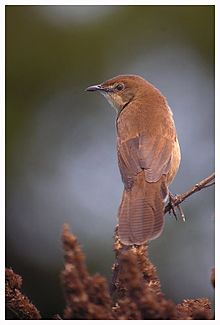Old World warblers are a large group of birds formerly grouped together in the bird family Sylviidae. The family held over 400 species in over 70 genera, and were the source of much taxonomic confusion. Two families were split out initially, the cisticolas into Cisticolidae and the kinglets into Regulidae. In the past ten years they have been the subject of much research and many species are now placed into other families, including the Acrocephalidae, Cettiidae, Phylloscopidae, and Megaluridae. In addition some species have been moved into existing families or have not yet had their placement fully resolved. A smaller family of warblers, together with some babblers formerly placed in the family Timaliidae and the parrotbills, are retained in a much smaller family Sylviidae.

The grass warblers are small passerine birds belonging to the genus Locustella. Formerly placed in the paraphyletic "Old World warbler" assemblage, they are now considered the northernmost representatives of a largely Gondwanan family, the Locustellidae.

The family Cisticolidae is a group of about 160 warblers, small passerine birds found mainly in warmer southern regions of the Old World. They were formerly included within the Old World warbler family Sylviidae.

Hippolais is a genus of tree warbler in the family Acrocephalidae. It is sometimes associated with the genus Iduna. The genus name Hippolais is from Ancient Greek hupolais, as misspelt by Linnaeus. It referred to a small bird mentioned by Aristotle and others and may be onomatopoeic or derived from hupo,"under", and laas, "stone".

The booted warbler is an Old World warbler in the tree warbler group. It was formerly considered to be conspecific with Sykes's warbler, but the two are now usually both afforded species status. Booted warbler itself breeds from central Russia to western China, and migrates to winter in the Indian subcontinent as far south as Sri Lanka. Booted warbler has expanded its breeding range westward in recent decades and nests now as far west and north as Finland. It is a small passerine bird, found in open country with bushes and other tall vegetation. 3-4 eggs are laid in a nest in a bush or vegetation. Like most warblers they are insectivorous.

The Sri Lanka bush warbler, also known as Ceylon bush warbler or Palliser's warbler, is an Old World warbler which is an endemic resident breeder in Sri Lanka, where it is the only bush warbler.
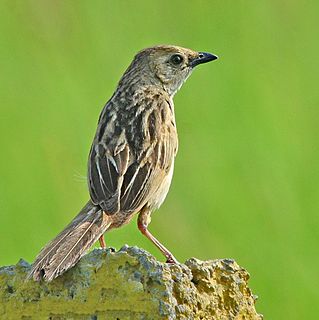
The bristled grassbird is a small passerine bird in the genus Schoenicola. Also known as the bristled grass warbler, this species is endemic to the Indian subcontinent, where it is patchily distributed in Bangladesh, India, Nepal and Pakistan. These insectivorous birds skulk in dense and tall grasslands, often in marshy areas, habitats that are threatened by human activities. Formerly considered to be sedentary, the species may be migratory, moving south and east in the Indian peninsula during winter and returning to their breeding grounds in the northern plains south of the Himalayas.

Stenostiridae, or the fairy flycatchers, are a family of small passerine birds proposed as a result of recent discoveries in molecular systematics. They are also referred to as stenostirid warblers.
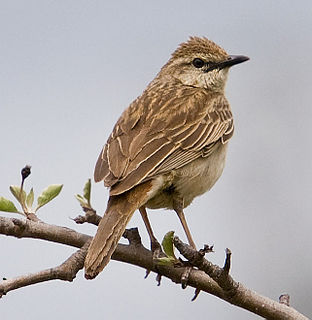
Cincloramphus is a genus of birds in the grassbird family Locustellidae.

The striated grassbird is an "Old World warbler" species in the family Locustellidae. It was formerly placed in the family Sylviidae. It is now the only species placed in the genus Megalurus.
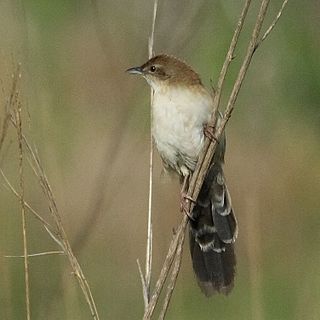
The fan-tailed grassbird or broad-tailed warbler is an African species of Old World warbler in the family Locustellidae. The species is closely related to the broad-tailed grassbird of India, and is sometimes treated as the same species, although a 2018 study found that it and broad-tailed grassbird were not closely related with the Indian species being a sister of Chaetornis striata.
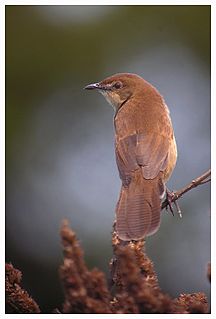
The broad-tailed grassbird is a species of Old World warbler in the family Locustellidae. It is endemic to the Western Ghats of India with a possibility of occurrence in Sri Lanka. A small, mostly brown bird, it has a broad rounded and graduated tail. It is found only on the higher altitude grassy hills where it usually skulks, except during the breeding season when males fly up into the air to sing in their display. The species is believed to be a resident although it is possible that they make local movements.

Seicercus is a genus of Old World warbler formerly in the family Sylviidae but now placed in Phylloscopidae. Recent scientific studies have recommended synonymizing this genus with Phylloscopus, and are placed there.
Alström's warbler, or plain-tailed warbler is a species of Old World warbler in the family Phylloscopidae. The species was first described in 1999. It breeds only in China, and winters in Thailand, Laos, Cambodia and Vietnam. Its natural habitat is temperate forests.

Locustellidae is a newly recognized family of small insectivorous songbirds ("warblers"), formerly placed in the Old World warbler "wastebin" family. It contains the grass warblers, grassbirds, and the Bradypterus "bush warblers". These birds occur mainly in Eurasia, Africa, and the Australian region. The family name is sometimes given as Megaluridae, but Locustellidae has priority.
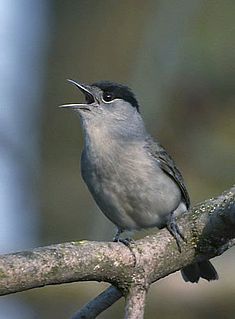
Sylvioidea is a superfamily of passerine birds, one of at least three major clades within the Passerida along with the Muscicapoidea and Passeroidea. It contains about 1300 species including the Old World warblers, Old World babblers, swallows, larks and bulbuls. Members of the clade are found worldwide, but fewer species are present in the Americas.

The jungle babblers, Pellorneidae, are mostly Old World passerine birds belonging to the superfamily Sylvioidea. They are quite diverse in size and coloration, and usually characterised by soft, fluffy plumage and a tail on average the length of their body, or longer. These birds are found in tropical zones, with the greatest biodiversity in Southeast Asia and the Indian subcontinent.

The Mongolian short-toed lark or Sykes's short-toed lark is a species of lark in the family Alaudidae. It breeds in China and Mongolia and winters in southern Asia.

Helopsaltes is a genus of passerine birds in the grassbird family Locustellidae.

Poodytes is a genus of passerine birds in the grassbird family Locustellidae.
